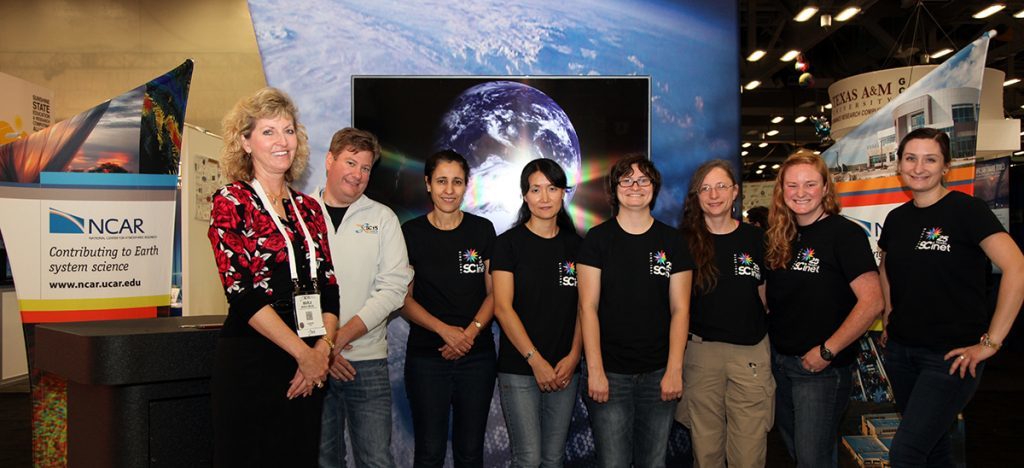Aug. 30 — Seven women who work in IT departments at research institutions around the country have been chosen to help build and operate SCinet, the very high capacity SC conference network, under the “Women in IT Networking at SC (WINS)” program.
Now in its second year, WINS is a collaboration between the University Corporation for Atmospheric Research (UCAR), the Department of Energy’s Energy Sciences Network (ESnet) and the Keystone Initiative for Network Based Education and Research (KINBER). Although women have been members of SCinet since the earliest days, but WINS was launched to further expand the diversity of the SCinet volunteer staff and provide professional development opportunities to highly qualified women in the field of networking.
Each year, volunteers from academia, government and industry work together to design and deliver SCinet. Planning begins more than a year in advance and culminates in a high-intensity, around-the-clock installation in the days leading up to the conference.
“This is really a once-in-a-lifetime opportunity – I’m very excited and very proud,” said Kali McLennan, a systems analyst at the Oklahoma Supercomputing Center for Education and Research at the University of Oklahoma who was chosen to participate. “I’m looking to soak up as much knowledge as I can from the experts on SCinet and form working relationships with people to talk with in the future on various topics.”
McLennan added that low oil prices have put the squeeze on her state’s economy and the university has strict limits on travel. “If it weren’t for this program, I would have to pay for my own trip or not be able to attend.”
Other participants are Angie Asmus, Colorado State University; Denise Grayson, Sandia National Laboratories; Julie Locke, Los Alamos National Laboratory, Amber Rasche, North Dakota State University; Jessica Shaffer, Georgia Institute of Technology; and Julia, Staats, CENIC. Indira Kassymkhanova of Lawrence Berkeley National Laboratory will participate in the program, but is not funded by WINS.
The National Science Foundation (NSF) will provide funding for participants from universities and the Department of Energy will support the women from the national laboratories.
Locke from Los Alamos said she’s looking forward to working directly with the teams laying out the fiber to create the network. In her job at the lab, she’s been upgrading the switches powering the four internal networks at Los Alamos.
“I’m really excited by the opportunities. I want to see a group of people build this super-fast awesome network from the ground up,” Locke said. “I haven’t terminated fiber for 15 years and am looking forward to that. I also want to learn more about the higher level technical stuff, like the strategies of fiber and get into the hows and whys of programming switches.”
Marla Meehl of UCAR, who was able to expand her NSF funding to support WINS, said the program was created to help early to mid-career women in IT to expand their skills, build professional networks and serve as mentors for younger women and encourage them to pursue careers in technology. In all, 33 women from 13 states applied, of whom 25 met all of the requirements, compared to 19 applicants last year.
“Although there are more jobs in IT, there’s a massive shortage of workers, especially in the number of women in the field,” said Meehl, who is manager of UCAR’s network in Boulder, Colo. “It was really fulfilling this year to see a huge jump in the number of really qualified applicants. It was very hard to choose.”
Wendy Huntoon, who worked with Meehl, along with Mary Hester and Lauren Rotman of ESnet, to create WINS, understands the value of working on SCinet. She helped build the very first iteration of SCinet at the Supercomputing ’91 conference in Albuquerque.
“It was a great opportunity for hands-on experience and to interact with a broad group of people; a chance to help build a community,” said Huntoon, who is president and CEO of KINBER, the Pennsylvania research and education network. “That experience has helped me throughout my career in high performance computing and networking.”
Huntoon led the selection team and said they were looking for a variety of factors – applicants who had experience in networking, whose skillset matched their area of interest, whose participation was supported by their institution, and who added to the group’s diversity, whether geographically, institutionally or otherwise.
ESnet’s Kate Mace, who joined the WINS management team this year, calls her experience as SCinet chair at SC14 “one of the best training experiences I’ve ever had. I worked with a lot of different personalities toward a common goal and learned a lot about the value of teamwork, coordination, communication and the value of documentation.”
She also cited the value of professional networking. It was through SCinet that she met ESnet staff and “got a pretty good feeling about the organization and the people.” In December 2015, she left Clemson University where she had worked for 15 years and joined ESnet’s Science Engagement Team.
Mace offered this advice to WINS participants: “Take time to understand how your tasks fit into the overall picture and if you don’t understand, don’t hesitate to ask questions,” she said. “There’s a wealth of information there – definitely take advantage of it. “Also, try and jot down things as you are experiencing them and benefitting from them, then relay them to your employer when you get back to convey the long-term value of the experience. Finally, build a professional network and don’t be afraid to access it.”

Source: SC16






























































